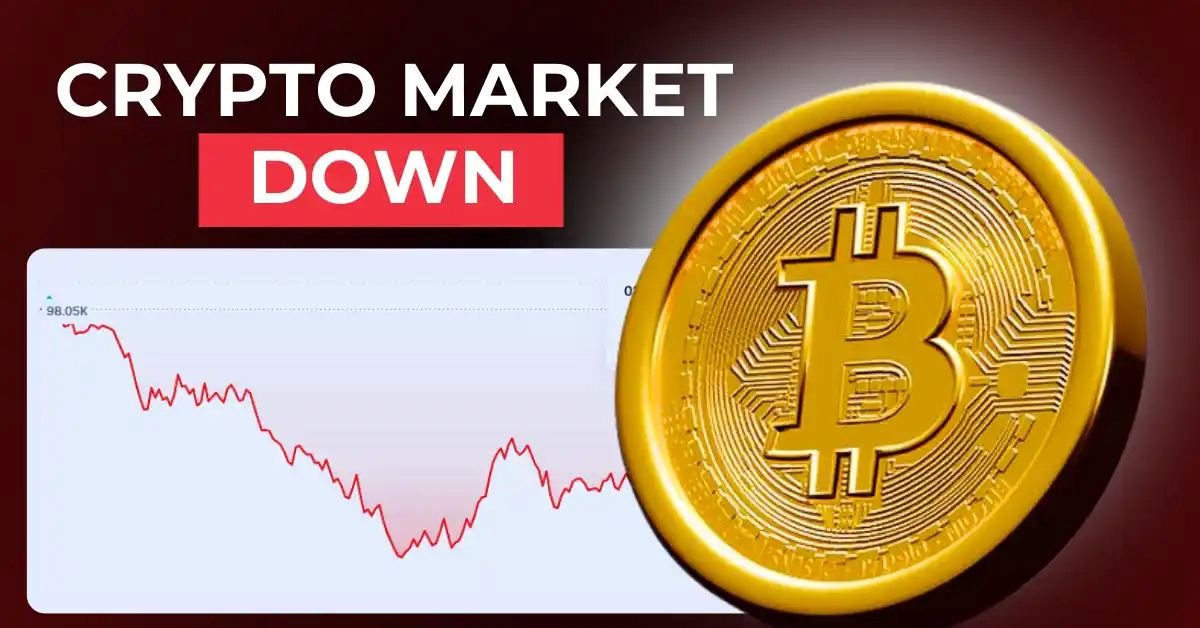Why Is Crypto Down Today? Unpacking the Major Drivers Behind the Market Dip

Did you wake up this morning, check your crypto portfolio, and feel a slight pang of anxiety? If so, you’re certainly not alone. The cryptocurrency market has been experiencing a significant dip over the past few hours, leaving many investors asking the burning question: “Why is crypto down today?” While the question might seem straightforward, the answer, as is often the case in the world of digital assets, is a complex tapestry woven from various, often unpredictable, factors. As an experienced journalist covering these volatile markets, I aim to provide you with a comprehensive understanding of the key forces contributing to this current crypto market downturn.
The cryptocurrency market is renowned for its inherent volatility. Prices can soar to unprecedented highs one day and tumble the next, a characteristic that defines both its thrill and its risk. Today’s XRP price jump and subsequent broader market correction isn’t an isolated incident; rather, it’s often the culmination of several interconnected global and internal market dynamics. Understanding these nuances is crucial for any investor navigating this fascinating yet challenging landscape.
1. Geopolitical Tensions and Global Economic Uncertainty
Whenever we ask, “Why is crypto down today?”, our gaze must first turn to the global stage. Geopolitical tensions, be they trade disputes, regional conflicts, or even heightened diplomatic friction, frequently trigger a “risk-off” sentiment across traditional financial markets. When investors sense instability, they tend to reallocate their capital to assets perceived as more stable or less risky, which inevitably puts downward pressure on riskier assets, including cryptocurrencies.
Recent reports suggest that tensions are indeed escalating in certain global regions. For instance, stalemates in trade negotiations between major economic powers like the U.S. and China, or rising unrest in the Middle East, can profoundly impact investor sentiment. When there’s uncertainty among large economies, it creates ripple effects across global markets. The crypto market, now far more intertwined with the broader global financial system than ever before, is not immune to these influences. Even though Bitcoin is often hailed as “digital gold” or a safe haven asset, short-term uncertainty frequently leads to liquidation and a reduction in risk exposure, especially where leverage is involved. This flight to safety often exacerbates any Bitcoin price decline and drags down the wider market.
2. Large-Scale Liquidations and the Impact of Leverage
In the crypto market, “liquidation” is a term that sends shivers down many investors’ spines. It occurs when traders, using borrowed capital (leverage) to amplify their bets, find the market moving against them. When the value of their collateral falls below a certain threshold, exchanges automatically close their positions to prevent further losses. Mass liquidations can be a significant factor in explaining the reasons for crypto market drop like the one we’re witnessing today.
Recent data has highlighted that hundreds of millions of dollars worth of crypto futures positions have been liquidated in the past 24 hours. A substantial portion of these were “long” positions – trades betting that prices would rise. When such massive amounts of leveraged positions are forcibly closed, it injects additional selling pressure into the market, pushing prices even lower and often creating a cascading effect. This phenomenon underscores the pervasive level of highly leveraged bullish positions in the market and illustrates how even a modest initial dip can trigger widespread selling, contributing to a broader cryptocurrency market dip.
3. Technical Breakdowns and the Breach of Key Support Levels
Technical analysis is a cornerstone for understanding market trends in any asset class, and crypto is no exception. A contributing factor to today’s cryptocurrency market dip could very well be the breakdown of crucial technical support levels. When the total crypto market capitalization, or the value of major cryptocurrencies like Bitcoin, breaches a significant support level on the charts, it frequently triggers algorithm-driven selling and a wave of stop-loss orders.
For example, if the total crypto market capitalization breaks below a critical support level such as $3.35 trillion, this signifies a technical failure. This then generates additional downward momentum that impacts all major digital assets, including Bitcoin, Ethereum, and numerous altcoins. Technical analysts keep a keen eye on such levels, as their breach often signals further declines. When key support lines that have held firm for days or weeks give way, it can signal a shift in market sentiment from bullish to bearish, contributing directly to a Bitcoin price decline and a widespread crypto market downturn.
4. ETF Outflows and Diminished Institutional Participation
The launch of spot Bitcoin ETFs over the past year ushered in a new era of institutional capital flow into the crypto market. Significant investments into these ETFs propelled Bitcoin prices to new all-time highs. However, one of the reasons for crypto market drop today could be a reversal of this trend: outflows from these very ETFs.
If spot Bitcoin ETFs have registered net outflows, it indicates a decrease in institutional buying pressure. When large investors or institutions liquidate their holdings, it adds a bearish sentiment to the market. Following several days of consistent inflows, a sudden shift to outflows can signal a “risk-off” mentality among institutional players, directly contributing to a Bitcoin price decline and affecting the entire market. The behavior of institutional capital can significantly influence market trends, and their withdrawal can remove a key pillar of support for prices. This phenomenon is critical to understanding why is crypto down today.
5. Profit-Taking and Market Psychology
Often, after a substantial market rally, profit-taking is a natural and expected process. If Bitcoin recently reached impressive highs, such as over $107,000, it creates a strong incentive for investors and traders to book their profits. This behavior is common following a robust rally, especially when prices achieve new all-time highs. The ensuing selling not only pulls Bitcoin’s price down but also creates a ripple effect that extends to other cryptocurrencies, contributing to a broader cryptocurrency market dip.
Beyond profit-taking, the crypto market is highly driven by emotion. Fear, Uncertainty, and Doubt (FUD) can spread incredibly rapidly, often amplified by social media. Emotional trading, particularly by retail investors, frequently leads to overreactions to news or price movements. When the market experiences a decline, “panic selling” can commence, where investors, driven by fear, sell off their holdings, which further exacerbates the price drop. This interplay of profit-taking by larger entities and emotional selling by retail investors is a classic dynamic explaining why is crypto down today.
6. Regulatory Uncertainty and Policy Announcements
Governments and regulatory bodies around the world are still grappling with how to classify and regulate cryptocurrencies. Any new regulatory announcement, news of a ban, or even mere rumors can send shockwaves through the market. For instance, news of countries like China imposing stricter regulations or outright bans on cryptocurrencies has historically triggered market downturns.
also read :-XRP Price Jump: Bulls Charge Through Key Resistance, Eyeing a Significant Upside
In the United States, the monetary policy of the U.S. Federal Reserve also profoundly influences the crypto market. Uncertainty surrounding upcoming U.S. inflation data or the Fed’s stance on interest rates can prompt investors to move away from risky assets, thereby reducing demand for crypto. If the Fed signals a more hawkish (tighter money) stance, it can lead to a stronger dollar and lower liquidity, making risk assets less attractive. These cumulative factors all contribute to the reasons for crypto market drop.
Conclusion: Further Dip or a Buying Opportunity?
There are multifaceted reasons for crypto market drop today, including geopolitical tensions, large-scale liquidations, technical breakdowns, ETF outflows, and investor profit-taking. It’s a complex web where one factor often influences another.
However, it’s crucial to remember that the crypto market is known for its long-term growth potential. Often, such corrections are viewed by seasoned investors as “buying opportunities.” The key is to conduct your own thorough research (DYOR), stay informed about market news, and avoid making impulsive decisions based purely on emotion. Short-term volatility is likely to persist, but the underlying fundamentals of major cryptocurrencies often remain strong. Always invest with a long-term perspective and only invest what you can afford to lose.
What are your thoughts on today’s crypto market movements? Share your insights and analysis in the comments below!




